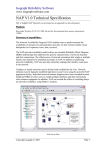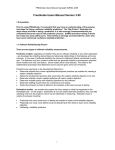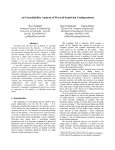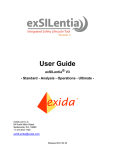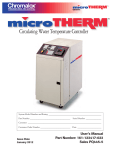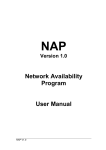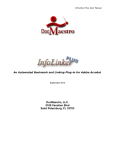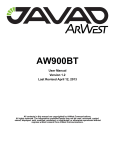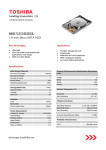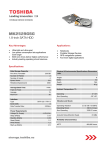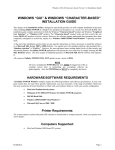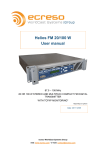Download WhenToStop Frestimate Module User`s Manual
Transcript
WhenToStop Software Users Manual Copyright SoftRel, LLC, 2008 WhenToStop Frestimate Module User's Manual 4.0 OVERVIEW .................................................................................................... 3 4.1 GENERAL INPUTS ........................................................................................ 5 4.2 INPUT FAILURE DATA ................................................................................. 8 4.2.1 Record Failures Per Day 8 4.2.1.1 Buttons .......................................................................................................................................... 10 4.2.2 Importing Data 13 4.3 PARAMETERS ESTIMATED ....................................................................... 16 4.3.1 Observed data 17 4.3.2 How parameters are estimated 17 4.3.2.1 Estimated inherent defects and initial failure rate ......................................................................... 17 4.3.2.2 Logarithmic model parameters ..................................................................................................... 18 4.3.2.3 Binomial model parameters .......................................................................................................... 18 4.3.2.4 NHPP parameters.......................................................................................................................... 19 4.3.2.5 Weibull parameters ....................................................................................................................... 19 4.3.3 Bypassing estimates for inherent defects, initial failure rate 20 4.4 SUMMARY RESULTS FOR ALL MODELS ................................................. 21 4.5 DETAILED RESULTS .................................................................................. 22 4.5.1 Select the model that you want to see results for 22 4.5.2 Select the curve fitting method 22 4.5.3 Outputs 23 4.5.3.1 Defect and test data ....................................................................................................................... 23 4.5.3.2 Estimated Current Failure Rate and MTTF .................................................................................. 24 4.5.3.3 Estimated End of Test Failure Rate and MTTF ............................................................................ 25 4.5.3.4 Estimated Operational Failure Rate and MTTF............................................................................ 25 4.5.3.5 Estimated Reliability .................................................................................................................... 26 4.5.3.6 Test hours needed to reach objective MTTF ................................................................................ 26 4.5.3.7 Defects to discover to meet objective MTTF................................................................................ 28 4.6 MODEL SENSITIVITY .................................................................................. 29 4.6.1 NHPP Model 31 4.6.2 Binomial Model 32 1 WhenToStop Software Users Manual Copyright SoftRel, LLC, 2008 4.6.3 Exponential Time to Failure Model 33 4.6.4 Logarithmic (Time) Model 34 4.6.5 Logarithmic (fault count) Model 35 4.6.6 Exponential fault count model 36 4.6.7 Bayesian model 37 4.6.8 Weibull Model 38 4.7 COMPARE ................................................................................................... 39 4.8 DEFECT TRENDS........................................................................................ 41 4.8.1 Failure Rate/MTTF 42 4.8.2 All Actuals to Estimates 44 4.8.3 Most recent actuals to estimates 45 4.8.4 Defect Trend 46 4.8.5 Test Time Trend 47 4.8.6 What will MTTF be after this many more testing hours 48 4.8.7 Testing needed to remove % defects 49 4.8.8 Staffing trend 50 4.8.9 Cumulatives Trend 52 4.8.10 Testing needed to reach some objective 53 4.9 ADDENDUM ................................................................................................. 54 2 WhenToStop Software Users Manual Copyright SoftRel, LLC, 2008 4.0 Overview WhenToStop used to be a standalone software estimation product. It is now an integrated module in the Frestimate software tool set. This module is purchased as part of the Frestimate Manager’s Edition. If you have purchased the Manager’s Edition the “Test data/growth” button shown below will be enabled. Otherwise it will be dimmed. This button is how you access the reliability estimation models in WhenToStop WhenToStop differs from the other modules in Frestimate because it does estimation as opposed to prediction. To use WhenToStop you must have observed failure data from testing or operation. Predictions, on the other hand, can be performed without observed failure data. The prediction models in Frestimate including full-scale, ShortCut, and Rome Labs, compliment WhenToStop in that you can use WhenToStop to validate the predictions made without observed failure data. You can also use the results of the predictive models as seeding values for the WhenToStop models. It should 3 WhenToStop Software Users Manual Copyright SoftRel, LLC, 2008 be noted that you can use the estimation models without doing a prediction and vice versa. When you select the “Test data/growth” button the below WhenToStop main page will be displayed. 4 WhenToStop Software Users Manual Copyright SoftRel, LLC, 2008 4.1 General inputs Select the “General Inputs” button from the WhenToStop main page shown in section 4.0. The start of test date affects the calculations for: • Estimated inherent defects - N0 • Estimated current failure rate - λp • Estimated current MTTF - MTTFp Start of test is the milestone in which the software has been integrated and is now ready for a system level verification and validation. The start of test milestone is denoted by the 0 subscript By this milestone, the developer unit tests and integration tests should already be complete for the particular software package. If you have incremental or spiral releases, this would be the point in time for which this increment or spiral is ready for a system level test. You will probably need to create a new project database for each spiral or increment as well. The start date will always be equal to the earliest date in the failure database. If you had no defects on the earliest date(s) of testing, you need to add records for these dates and set the defects fields to 0. This will allow the models to take into account periods of time with no failures. The end date defaults to the most recent date in the failure database. You can override this in this dialog as long as it is not less then the start date. The end of test date affects the calculations for: • End of Test MTTF - MTTFdel 5 WhenToStop Software Users Manual Copyright SoftRel, LLC, 2008 • End of Test Failure Rate - λdel • Estimated end of test reliability The start and end date are very key pieces of information. The end date must be greater then or equal to the start date. This milestone is denoted by the DEL subscript in this manual. If you set the start and end dates so that no date in the failure database falls within the range between the start and end dates, an error message will be displayed. The Post Delivery Usage inputs directly affect the calculations that are output. The prediction menu has a wizard to help you determine the below inputs. Number of months in growth period - This field must be a non-negative integer. This is the number of months after delivery in which you expect the failure rate to go down or the MTTF to go up. Usually this is equal to the number of months between this release and the next major release. While 0 is a valid input, it is not recommended. If the growth period is set to zero this is equivalent to stating that all inherent defects will be found immediately upon delivery. The months in the growth period is used by the following calculations. • Operational MTTF • Operational Failure Rate • Estimated operational reliability • Number of hours operating per month - This field must be a positive numeric value. It is the duty cycle and is used to normalize the testing time observed to the operational time that will be observed by the end users. If the software will operate continuously by the end user then the default is approximately 730 times the number of fielded units that are running this software. The results of these outputs are directly related to what you input for operating hours per month: • Operational MTTF • Operational Failure Rate • Estimated reliability for mission time specified and operational failure rate Mission time period (in hours) over which reliability will be measured - This field must be a non negative numeric value. Mission time should not be confused with testing time. Mission time is a finite period of time over which reliability will be measured. Let’s say your product is a dishwasher with an average cycle time of 60 minutes. Then the mission time would be 60 minutes. If your product is a medical therapy with an average therapy injection time of 8 hours then the mission time would be 8 hours. The results of these outputs are directly related to what you input for mission time. • Estimated current reliability • Estimated end of test reliability • Estimated operational reliability 6 WhenToStop Software Users Manual Copyright SoftRel, LLC, 2008 Desired MTTF - The desired MTTF is often abbreviated as MTTFobj and the desired failure rate as λobj. Each of these fields must be a positive and finite numeric value. The end of test objective is the objective with no growth at delivery day. The desired MTTF after the growth period is the desired MTTF after whatever number of months you have input for the growth period. If you enter 0 months of growth then these two values should be the same as there is no growth. Desired MTTF is generally computed based on system reliability, software reliability, system availability, software availability objectives or a requirement to remove some specific percentage of the defects in the software prior to shipment. The results of these two outputs are directly related to the desired MTTF: • Test hours needed to reach objective MTTFobj • Defects to discover to meet objective MTTFobj 7 WhenToStop Software Users Manual Copyright SoftRel, LLC, 2008 4.2 Input Failure Data To use the estimation models, you must input failure data from systems testing. There are two ways to input this data. You can enter it directly one day at a time (Record failures per day) or you can import several days worth of testing data at once. 4.2.1 Record Failures Per Day Select the “Input Failures By Day” button from the WhenToStop main page shown in section 4.0. 8 WhenToStop Software Users Manual Copyright SoftRel, LLC, 2008 The following information is input for each day in the testing cycle: Date: Enter the date in which either testing was done and no failures occurred or testing was done and failures occurred. If you do not record data for a particular date, then WhenToStop will presume that no testing was done on that date. Time: This is the amount of time spent testing that day. Do not include development time or other time that did not result in operation of the software. Decide whether to use calendar time, CPU time or operational time in advance and be consistent in defining time from one record to the next. The default value for this field is 8 hours. If you leave zero in the time field, the system will assume that no testing transpired on this day and will ignore any information in the following fields. For each of the following fields these are the default, minimum and valid values: Default values - 0 Minimum values - 0 Valid values - Positive integers Number of catastrophic defects: You will need to determine what catastrophic means to your project. This classification is generally used for the “show stopper” defects that make the software unusable or have some effect on the end user, which is completely unacceptable. Number of catastrophic defects: You will need to determine what critical means to your project. This classification is generally used for the serious defects that are “show stoppers” but do not have a catastrophic impact on either your company or your end users. 9 WhenToStop Software Users Manual Copyright SoftRel, LLC, 2008 Number of moderate defects: You will need to determine what moderate means to your project. This classification is generally used for defects that have a workaround. Number of negligible defects: You will need to determine what negligible means to your project. This classification is generally used for the defects that are not very visible to your end users. Record number: The record number is shown on the left hand side of this dialog. It is read only and is used to help you toggle through the records in your database. 4.2.1.1 Buttons Print - This button prints out the contents of the current failure record. It is not enabled in the demonstration version. There are several functions available for finding particular records in the failure database: Next - This button will display the next record in the database. Previous- This button will display the previous record in the database. Top - This button will display the first record in the database. Bottom - This button will display the last record in the database. Bypass the System Calculations - If you have a lot of records in your database, it may take a while for the system to update the calculations every time you enter date. You can bypass the system calculations while you are entering data and then update them later by pressing the Estimation->Recalculate menu item. Append - This will add a new record to your database. The date will default to the latest date from your database. Delete - This will delete the record which is currently shown. Close - To close the Failure database and update all system parameters calculated by WhenToStop press the “Close” button at the bottom of the window. If there is a lot of data in your database, this can be a time consuming process. Therefore there is another option for closing. This option is “Bypass the system calculations>“. It will close the database and save it, but will not update the system calculations. You can later update the system with the close button. 10 WhenToStop Software Users Manual Copyright SoftRel, LLC, 2008 Table View - This shows the defect data as a list, allowing you to see all of the records at once. 11 WhenToStop Software Users Manual Copyright SoftRel, LLC, 2008 Cumulatives Table - This table shows the cumulative defect data, cumulative testing time and cumulative failure intensity for each point in time in which any of these values changed. The failure intensity is the cumulative defects divided by the cumulative time. When you select the Inherent defects trend, the failure intensity shown below is plotted on the x axis and the cumulative defects shown below is plotted on the y axis. If you have selected the global preferences option to filter only the serious defects then the serious defects column is plotted on the y axis. When you select the inherent time trend, the failure intensity shown below is plotted on the x axis and the cumulative test time shown below is plotted on the y axis. 12 WhenToStop Software Users Manual Copyright SoftRel, LLC, 2008 4.2.2 Importing Data You have the option of importing comma separated text files that contain the same data as shown in section 4.2.1. These are called .csv files and are exported by common office applications such as spreadsheets. You can output your failure logs in the .csv format and import them into Frestimate with this function. There is an example .csv file shipped with Frestimate, which you can use for reference. If your file is not formatted properly, Frestimate will inform you of this status. Select the “Import Failure Data” button from the WhenToStop main page shown in section 4.0. The below dialog is displayed. 13 WhenToStop Software Users Manual Copyright SoftRel, LLC, 2008 If you do not have the last 3 fields in the csv file, they will be ignored. However, you must have the first 3 fields in the exact format as shown here. Valid date ,Hours, Catastrophic defects,Critical defects,Moderate defects, Negligible defects Valid date: This can be in any date format. It is the date in which either testing was performed with no defects found or testing was performed and defects were found. Hours: The number of hours of testing performed on this date. Include hours of testing by all testers and users. This can exceed 24 hours. This field can be a floating or an integer value. Catastrophic defects, Critical defects, Moderate defects and negligible defects: If you know the severity of the defects found on this day then you can enter them according. Otherwise, the catastrophic defects should represent the total number of defects found. These values are expected to be integers. Short Example: 4/29/02 0:00:00,8.00,1,0,0,0 4/30/02 0:00:00,8.00,0,1,0,0 5/1/02 0:00:00,8.00,0,0,1,0 5/2/02 0:00:00,8.00,0,0,0,0 5/3/02 0:00:00,8.00,1,0,0,0 5/4/02 0:00:00,8.00,0,0,0,0 14 WhenToStop Software Users Manual Copyright SoftRel, LLC, 2008 Once the data is imported it is merged with whatever data you have entered via the "record failures per day". You can use both of these options in any order at any time. Duplicate entries are merged such that the defects from duplicate dates are added together. 15 WhenToStop Software Users Manual Copyright SoftRel, LLC, 2008 4.3 Parameters estimated Select the “Parameters Estimation” button from the WhenToStop main page shown in section 4.0. The below dialog is displayed. Parameters are calculated by Frestimate directly from the defect data that you enter. Every time you enter or change data, these parameters can and will change also. If you have a lot of data, these parameters can take a while to calculate. Parameters are used by the models to calculate failure rate and MTTF. 16 WhenToStop Software Users Manual Copyright SoftRel, LLC, 2008 4.3.1 Observed data These are observed data as opposed to estimated parameters. They are shown on this page mainly because they are inputs to the estimation models as are the parameters shown below them. n- number of defects found so far. This is the cumulative total of all defects in your database between the start and end date of systems testing. If you chose to filter only the severe defects in the global preferences then this value will include only the catastrophic and critical defects in the database between the start and end of systems testing. t- Cumulative test time - This is the total number of cumulative testing hours in your database between the start and end of systems testing. Growth rate Q0 - This is the observed growth rate of the defects in your database between the start and end of systems testing. If you chose to filter only the severe defects in the global preferences then this value will include only the catastrophic and critical defects in the database between the start and end of systems testing. The growth rate is determined by plotting the failure intensity for each row in the cumulatives table (shown in section 4.2) versus the cumulative defects. The observed growth rate is the natural log of the x intercept of that graph over the y intercept of that graph. 4.3.2 How parameters are estimated 4.3.2.1 Estimated inherent defects and initial failure rate The estimated number of inherent defects - N0 - in the software at the start of system test is estimated by WhenToStop based on your collected data. Some models assume that inherent defects and initial failure rate is fixed and finite: • Binomial • Exponential fault count • Exponential time to failure Some models assume that inherent defects and initial failure rate is finite but not fixed: • NHPP • Weibull Some models assume that inherent defects and are infinite: • Logarithmic (time to failure) • Logarithmic (fault count) 17 WhenToStop Software Users Manual Copyright SoftRel, LLC, 2008 Some models make no assumption about inherent defects at all: • Bayesian Inherent defects - N0 Therefore, the inherent defects parameter is used by the Binomial, Exponential fault count, Exponential time to failure and NHPP models. The Weibull model uses it's own parameter estimation to determine inherent defects. For the other models, the parameter is estimated by plotting cumulative defect rate vs. cumulative defects, the y intercept of this plot will be the estimated inherent defects. Initial failure rate λ0 The x intercept will be the estimated initial failure rate which is used by the Binomial, Exponential fault count, Exponential time to failure and NHPP models. The logarithmic models use the ACTUAL observed initial failure rate which is just the cumulative defects divided by the cumulative time for the very first time period in which there were observed defects. If you look at the cumulative table in the Record Failures Per Day page, this will be the value for failure intensity that it is in the very first row of the table. There are 4 ways to determine the y and x intercepts. You select one of the below methods from the Estimation->Detailed Results page. • Best Straight LineLeast Squares EstimateWeighted Least Squares EstimateMaximum Likelihood Estimate You may do the modeling with the computed default value for inherent defects or you can modify it as discussed shortly. 4.3.2.2 Logarithmic model parameters The exponential models presumes that there is a straight line between the inherent defects estimate N0 and the initial failure rate λ0 estimate when plotting the cumulative defects vs. the failure intensity. Logarithmic models, on the other hand presume that this plot is not a straight line but rather a logarithmic curve. Since slope cannot be used in this case, the rate of change of the curve is used instead. Theta - θ - is the rate of change between the initial failure rate and the current failure rate. This is also called the failure rate decay. If you plot the natural log of failure intensity versus cumulative defects, the slope of this plot is theta. 4.3.2.3 Binomial model parameters 18 WhenToStop Software Users Manual Copyright SoftRel, LLC, 2008 k parameter - This parameter is calculated by WHENTOSTOP as the inverse of the slope of the line of cumulative defects vs. failure intensity trend. The k parameter is only used by the Binomial model. 4.3.2.4 NHPP parameters The NHPP a parameter is estimated to be approximately equal to number of inherent defects N0 in the software at the start of system test. The NHPP model assumes that inherent defects are finite but not fixed. The NHPP b parameter is estimated to be approximately equal to the initial failure rate λ0 of the software at the start of system test. The NHPP model assumes that inherent defects N0 are finite but not fixed. Therefore, initial failure rate is also assumed to be finite but not fixed. Simultaneous equations are used to determine the NHPP a parameter. [EQ 1] a = Σ f(i) / (1 - e -(bt)) [EQ 2] at * e-bt = Σ? [f(i) * ((ti * e-bt(i)) - (ti-1* e-bt(i-1))) / (e-bt(i-1) - e-bt(i))] Hint: solve for “a” with first equation. Find values for “b” that make equation 2 equal on both sides. 4.3.2.5 Weibull parameters a Weibull parameter This is a slope parameter of the natural log of the defect detection times plotted on the x axis and ln(ln(1/1-Fi) where Fi is the ni /N for each time interval in which a defect was detected. You can see this parameter estimation in the Model Sensitivity->Weibull->Weibull Parameter estimation page. b Weibull parameter b0 = the y intercept of the natural log of the defect detection times plotted on the x axis and ln(ln(1/1-Fi) where Fi is the ni /N for each time interval i in which a defect was detected. b = exp(-b0/a) Weibull Inherent Defects parameter When you have the Weibull model selected in the results page the below value will be displayed as the Inherent defects. 19 WhenToStop Software Users Manual Copyright SoftRel, LLC, 2008 N0 = (exp(-b0/a)) Weibull k parameter = K = b/N0 4.3.3 Bypassing estimates for inherent defects, initial failure rate If you have historical data from a previous and similar software project, you may choose to override the system calculated parameters. This option is only for advanced users who have collected historical data. To choose this option check the “Use this value for total inherent defects” and "Use this value for initial failure rate" and then enter the inherent defects and the initial failure rate. WhenToStop will do no checking of these parameters other than to make sure that both are positive numbers. You cannot leave either field blank if you check this option. 20 WhenToStop Software Users Manual Copyright SoftRel, LLC, 2008 4.4 Summary results for all models Select the “Summary Results for all models” button from the WhenToStop main page shown in section 4.0. The below page is displayed. This selection will display the inputs to all of the models and will generate output for all model calculations. You can use this function to compare the results of each of the models in one summary report. You can print this dialog or close it. The dialog shows the nominal MTTF and failure estimates. It also shows the 5% and 95% confidence limits on these values. The confidence bounds are determined by • Establish confidence = .95 • Using normal charts determine Z (.95)/2 • Lower interval = estimated parameter - Z (.95)/2 v(Variance(estimated parameter)) • Upper interval = estimated parameter + Z (.95)/2 v (Variance(estimated parameter)) • Use the lower and upper interval estimates in the failure rate and MTTF formulas to determine a 5% and 95% bound The formulas used to compute the above values are shown in section 4.6 of this manual. 21 WhenToStop Software Users Manual Copyright SoftRel, LLC, 2008 4.5 Detailed results The detailed results are shown on the WhenToStop main page. If there are no results shown then that means that you need to enter failure data and/or general inputs. 4.5.1 Select the model that you want to see results for You can toggle among any of the models selected here to view the most current estimates for each model. All model results are stored in the database, however, only the model that you select in this dialog is displayed on this page or the reports. 4.5.2 Select the curve fitting method 22 WhenToStop Software Users Manual Copyright SoftRel, LLC, 2008 The preferred curve fitting is the technique used to estimate certain parameters used for some or all of the models. These parameters include: • k parameter • Inherent Defects - N0 • Initial Failure Rate λ0 Whenever you change the curve fitting options, the system will automatically recalculate the results that are shown in this page. If there is allot of data in the failure database, this may take a while. The curve fitting options are: • Best Straight Line. This best straight line can be viewed from the defect trends menu item. Select “inherent defects” trend and then select “linear”. • Least Squares Estimate.This technique generally takes less time then the MLE estimation and often times less time then the best straight line.Weighted Least Squares EstimateThis technique is just like the LSE except that most recent data points are weighted heavier.”.Maximum Likelihood Estimate This method of estimating parameters will generally take longer to perform then the other calculations. 4.5.3 Outputs All MTTF outputs are in terms of hours. All failure rate units are defined based on the selection you made in the File->Global Preferences dialog. If you chose hours, then all failure rate outputs will be in hours. The same applies to million of hours and billion of hours. You can change this preference at any time and the failure rate outputs as well as the labels will be updated accordingly. 4.5.3.1 Defect and test data Estimated inherent defects - This is the estimated parameter associated with the model and the curve fitting method that you selected. See section 4.3 for a description. Defects found so far in testing - This is the actual defects in the database. See section 4.3 for a description. End of testing date - This is the date that you entered on the general inputs page. Defects estimated between now and end of testing - This is an extrapolation of the present defect count using the model that you selected. The extrapolation formula depends on the model selected as shown below. Note: If the end of testing date has already passed, then the above estimate will be 0. 23 WhenToStop Software Users Manual Copyright SoftRel, LLC, 2008 4.5.3.2 Estimated Current Failure Rate and MTTF These results are calculated based on: • • • • • The model you selected The curve fitting you selected The failure data that you entered The time values that you entered The start date you entered The model for determining the failure rate depends on which model is selected. Refer to section 4.6 for the model formulas. Please note that MTTF is not always the inverse of the failure rate. They can be inverted only when there is a constant hazard rate such as the NHPP, exponential and binomial models. Parameters associated with the present point in time are often denoted with a subscripted p in this manual. 24 WhenToStop Software Users Manual Copyright SoftRel, LLC, 2008 4.5.3.3 Estimated End of Test Failure Rate and MTTF The end of test failure rate is an extrapolation of the current failure rate up to the end date that you entered in the preferences. The number that is displayed here is calculated based on: • • • • • The model you selected The curve fitting you selected The failure data that you entered The start date you entered in the preferences The end date you entered in the preferences The formulas for extrapolating the present failure rate/MTTF to the future failure rate/MTTF using ∆t which is the testing hours remaining between now and the end of testing milestone: Model Binomial and exponential models NHPP model Logarithmic models Weibull model Formula to extrapolate the present to end of test λDel = λp * exp(-k∆t) MTTFDel = 1/λp * exp(-k∆t) λDel = λp * exp(-b∆t) MTTFDel = 1/ λp * exp(-b∆t) MTTFDel = (θ∗∆t) + MTTFp λDel = 1/ (θ ∗ ∆ t + MTTFp) λDel = a*b*(t*b) a-1exp(-(t+∆t)*b )a Parameters associated with the end of test milestone are often denoted with a subscripted DEL in this manual. Parameters associated with the present time are often denoted with a subscripted p in this manual. 4.5.3.4 Estimated Operational Failure Rate and MTTF The operational failure rate is an extrapolation of the end of test failure up to the end of the growth period that you specify in the General Inputs page. The model you have selected is used to extrapolate the end of test failure rate, but then the exponential model is used to extrapolate past the end of test. The number that is displayed here is calculated based on: • • • • The model you selected The curve fitting you selected The failure data that you entered The start date you entered in the general inputs 25 WhenToStop Software Users Manual Copyright SoftRel, LLC, 2008 • The end date you entered in the general inputs • The growth period and duty cycle specified in the general inputs Operational MTTF = T/ Ndel ((exp (-Q*(i-1)/i)-exp(-Q)) Operational failure rate = λ = 1/Operational MTTF Where: T = duty cycle per month that you input in the Estimation->General Inputs page. Ndel = N0 - n - number of defects estimated between now and end of test Q = growth rate computed by WhenToStop and shown on the estimation parameters page i = number ofmonths in growth period that you entered on the General inputs page. Note: The estimates for the operational milestone are denoted with no subscript. 4.5.3.5 Estimated Reliability The estimated current reliability is computed by the following algorithm. It is the probability that the software operates over the mission time. λp - estimated present failure rate λdel - estimated end of test failure rate λ − operational failure rate Using an exponential formula: Estimated current reliability = exp (-λp * mission time) Estimated end of test reliability = exp (-λdel * mission time) Estimated operational reliability = exp (-λ* mission time) The reliability formulas for the models that are not exponential are shown in section 4.6. Reliability is calculated based on: • The model you selected • The curve fitting you selected • The failure data that you entered • The start date you entered general inputs • The mission time that you entered in the general inputs 4.5.3.6 Test hours needed to reach objective MTTF 26 WhenToStop Software Users Manual Copyright SoftRel, LLC, 2008 The current MTTF is extrapolated to the objective MTTF and the system determines the amount of test time needed for that extrapolation. It is calculated based on: • The model you selected • The curve fitting you selected • The failure data that you entered • The start date you entered in the General Inputs page • The objective MTTF you entered in the General Inputs page Additional test hours are denoted as ∆t in this manual. Objective MTTF or failure values are denoted with an obj subscript. Model Formula to determine additional testing hours needed Binomial and ∆t = ( N0/ λ0* ln(λp / λobj ) exponential models NHPP model ∆t = ( 1/ b* ln(λp / λobj ) Logarithmic models Weibull model ∆t= (1/ θ * ((1/ λf) -(1/ λp)) Solve for ∆t by optimizing this formula λobj = a*b*(t*b) a-1exp(-(t+ ∆t)*b )a 27 WhenToStop Software Users Manual Copyright SoftRel, LLC, 2008 4.5.3.7 Defects to discover to meet objective MTTF The current MTTF is extrapolated to the objective MTTF and the system determines the amount of defects that would need to be discovered for that extrapolation. It is calculated based on: • • • • • The model you selected The curve fitting you selected The failure data that you entered The start date you entered in the General Inputs page The objective MTTF you entered in the General inputs page Additional defects are denoted as ∆n in this manual. Objective MTTF or failure values are denoted with an obj subscript. Binomial and Exponential models. NHPP model Logarithmic models Weibull model ∆n = ( N0/ λ0* (λp − λf) 1/k = N0/λ0 ∆n = ( 1/ b* (λp − λf) ∆n = (1/ θ * ln(λp/ λf) λobj = a*b*(t*b) a-1exp(-(t+∆t)*b )a Once you solve for ∆t then compute defects associated with that time by solving for b and keeping a the same. 28 WhenToStop Software Users Manual Copyright SoftRel, LLC, 2008 4.6 Model Sensitivity Select the “Model Sensitivity” button from the WhenToStop main page shown in section 4.0. The model parameters that are associated with the model that you have selected will then be displayed. For example, if you have chosen the Binomial model in the pull-down menu then the inputs for the Binomial model are shown and you are able to do the sensitivity analysis on those parameters. Each of the sensitivity pages is shown in sections 4.6.1 through 4.6.8. The following software reliability models capabilities are included in WhenToStop: Present failure Present MTTF Reliability estimation rate estimation - estimation for present or end of test milestone* λp Binomial k(N0-n) 1/ λp Exp(-λx* mission) Time to kN0*e(-kt) 1/ λp Mission = mission time Failure Exponential λ0*(1- n / N0) 1/ λp fault count NHPP a * b * exp(-bt) 1/ λp Logarithmic λ0/((λ0* θ*t)+1) ()Τϕ 1 *0 0 1 283.08 (()Τϕ 409.2 1 0 0 Τµ 1 /393 (θ)Τϕ 409.2 1 0 Τµ 0 1(λ)Τϕ 289. ()Τϕ 1 0 0 1 340.56 400.08 Τµ (1)Τϕ 1/θ1 0 0 1 344.64 400.08 time based ()Τϕ 1 0 0 1 283.08 ()Τϕ 1394.56 0 0 1 Τµ 389.04 (λ)Τϕ394.56 ΕΤ θ 289.8 Τµ (λ Logarithmic λ0 * exp(-θn) ()Τϕ 1 *0 0 1 283.08 379.32 Τµ (θ)Τϕ 1 0 0 1 289 0 1 340.56 370.2 Τµ (1)Τϕ /Φ4 8.0391 Τφ 1 0 0 1 defect ()Τϕ 1 0 ()Τϕ 0 11 0283.08 364.68 Τµ (λ)Τϕ /Φ4 8.0391 based a Weibull b*a*(t*b)(a-1)* N0 Γ (1/a + 1) OR exp(-mission*b) a exp(-tk) Γ (1/a + 1)/ if a = 1 then you (b^(1/a))) have an exponential model if a = 2 then you have a Raleigh model *t = mission time, x = appropriate milestone subscript depending on whether we are solving for present or end of test milestone. If the milestone is the end of operational growth period then the exponential formula for reliability is used. WhenToStop computes all parameters and model results automatically when you enter failure data. The model options in this section allow you to: • View the parameters estimated for each model • View the results for each model • Temporarily change the inputs to perform sensitivity analysis 29 WhenToStop Software Users Manual Copyright SoftRel, LLC, 2008 The following functions are provided for each of the models: Reset values - You can modify the inputs for each model and view the results. If you want to clear your inputs and reset the values to those that were computed by WhenToStop then press this button. Print- This will print the form. Close- This will close the form but will NOT save any of your inputs. The model dialog screens allow you to perform analyses by modifying the input parameters to the models. They are not intended, however, to overwrite the system parameters computed by WhenToStop. Calculate values - If you change the default values in these dialogs, the calculate button will recalculate the failure rate and MTTF values for you based on the new inputs. It will not, however, overwrite the system parameters calculated by WhenToStop. When you exit this dialog the changes will not be saved. 30 WhenToStop Software Users Manual Copyright SoftRel, LLC, 2008 4.6.1 NHPP Model The inputs for the NHPP model are: • a parameter • b parameter • Test/usage time The outputs are: • Predicted MTTF in hours • Predicted failure rate in terms of the unit of time that you specified in the global preferences dialog Estimated failure rate = a * b * exp(-bt) Estimated MTTF = 1/ failure rate since this is an exponential model. Note that failure rate and MTTF for this model change only when there is a defect detected and not directly with calendar time. You can override the values of a, b and time to determine sensitivity on the MTTF and failure rate results. Your inputs and outputs are not saved once you close this dialog, however, you can print them. Section 4.8 describes the inputs for this model. The NHPP model assumes that faults do not have an equal probability of being detected. This model is typically used during the earlier phases of testing/usage. 31 WhenToStop Software Users Manual Copyright SoftRel, LLC, 2008 4.6.2 Binomial Model The inputs for the binomial model are: • Number of detected defects - n • k parameter • Inherent Defects N0 This model assumes that all faults are equal in probability of being detected and severity and that when a fault is detected it is immediately removed (corrected). Estimated failure rate = k (N0 - n) Estimated MTTF = 1/ failure rate since this is an exponential model. Note that failure rate and MTTF for this model change only when there is a defect detected and not directly with calendar time. 32 WhenToStop Software Users Manual Copyright SoftRel, LLC, 2008 4.6.3 Exponential Time to Failure Model The inputs for the exponential model are: • Inherent Defects - N0 • Initial Failure Rate - λ0 • Cumulative Test/Usage Time - t The exponential model assumes that the hazard rate is constant and that faults are equal in severity and probability of being detected. Failure rate = λ0* exp(- t * λ0 / N0) MTTF = 1/ failure rate since this is an exponential model. 33 WhenToStop Software Users Manual Copyright SoftRel, LLC, 2008 4.6.4 Logarithmic (Time) Model The inputs for the logarithmic model are: • Observed initial failure rate - λ0 • Cumulative test/usage time - t • Theta - θ The logarithmic model assumes that some faults are likely to be detected before others. This model is typically used earlier in test/usage than other models. It assumes that inherent defects is infinite and therefore does not model this parameter. Instead it models the initial failure rate and the change in that failure rate (theta). Estimated failure rate = observed λ0/ ((observed λ0* θ * t) + 1) 34 WhenToStop Software Users Manual Copyright SoftRel, LLC, 2008 4.6.5 Logarithmic (fault count) Model The inputs for the logarithmic fault count model are: • Observed initial failure rate λ0 • Theta - θ • Number of detected defects - n The logarithmic model assumes that some faults are likely to be detected before others. This model is typically used earlier in test/usage than other models. It assumes that inherent defects is infinite and therefore does not model this parameter. Instead it models the initial failure rate and the change in that failure rate (theta). This model differs from the time based logarithmic model only to the extent that failure rate is estimated as a function of defects as opposed to a function of time. Estimated failure rate = observed λ0 * exp (-θ * n) MTTF = θ / ( (1-θ) * ((observed λ0 * θ * t )+ 1) (1-1/θ) ) 35 WhenToStop Software Users Manual Copyright SoftRel, LLC, 2008 4.6.6 Exponential fault count model The inputs for this model are: • Observed Initial failure rate -λ0 • Cumulative test/usage time - t • Number of detected defects - n • Inherent Defects - N0 This model assumes that all faults are equal in probability of being detected and severity and that when a fault is detected it is immediately removed (corrected). Estimated failure rate = λ0 *(1- n / N0) Estimated MTTF = 1/ failure rate since this is an exponential model. Note that failure rate and MTTF for this model change only when there is a defect detected and not directly with calendar time. 36 WhenToStop Software Users Manual Copyright SoftRel, LLC, 2008 4.6.7 Bayesian model The inputs for this model are: • Number of detected defects - n • Cumulative test/usage time - t This model is useful for measuring software projects that are not failing often. The failure rate estimate is a function of time, therefore, if there is a period of time in which there is testing, but no failures found, this model will reflect it. This model makes no assumptions about inherent defects or initial failure rate. The formula for this model is: Estimated failure rate = (n + 1)/ t Estimated MTTF = t/ (n + 1) 37 WhenToStop Software Users Manual Copyright SoftRel, LLC, 2008 4.6.8 Weibull Model The inputs for the Weibull model are: • • • • Number of detected defects Test/usage time a Weibull parameter b Weibull parameter This model assumes that the failure rate can be increasing or decreasing. MTTF = (b/a) * Γ (1/a) Failure rate = a * (a /b) * (t/b) a-1 * exp(-t/b)a 38 WhenToStop Software Users Manual Copyright SoftRel, LLC, 2008 4.7 Compare The purpose of the “Compare” functions are to allow you to compare the estimated values for each of the models for each defect occurrence in the failure databases to the actual next time to failure. The actual next time to failure is equal to: Time to next failure = observed time between last failure and this failure You can view the following only when there is at least two defects recorded in the “record failures per day” database. Select the “Compare results” button from the WhenToStop main page shown in section 4.0. The model that is selected on the main WhenToStop page will be displayed for the comparison. These graphs are useful for determining if a particular model is currently estimating with the lowest relative error and/or what points in the testing phase was this model estimating with the lowest relative error. Relative error is computed by the absolute value of: (Estimated MTTF using this model - actual time to failure) / actual time to failure The relative error is computed for each MTTF computed at each defect occurrence as recording in the “record failures per day” database. Estimated MTTF for each model is also computed based on the curve fitting and model selected in the Estimation->Detailed results page. The relative errors are then averaged for each model and displayed on this plot. You can print this plot or close it. 39 WhenToStop Software Users Manual Copyright SoftRel, LLC, 2008 Each of the compare estimate plots has the ability for: • Export • Copy to Clipboard • Print Export This will export the graph to a predefined file name. This file name will be displayed to you and it will be saved in the same folder that Frestimate is running in. You can import this exported graph into various office applications. Copy to Clipboard - This works just like the export function except that the graph is saved in the clipboard. You can open an office application and press "paste" and the image will be pasted from the clipboard. Print - This will print the entire screen to your printer. 40 WhenToStop Software Users Manual Copyright SoftRel, LLC, 2008 4.8 Defect Trends Select the “Select a trend” pull-down menu from the WhenToStop main page. Each of these trends is generated from the failure data that you input for a specific project. You can print your trend by pressing the "Print" button on the trend screen. 41 WhenToStop Software Users Manual Copyright SoftRel, LLC, 2008 4.8.1 Failure Rate/MTTF Select the Failure Rate/MTTF option from the pull-down menu. (It is the very first option). Then you can toggle between the failure rate growth and the MTTF growth graphs as shown below. These graphs show an extrapolation of the fielded failure rates and MTTF values given your inputs for end of testing, duty cycle and growth period. While end of test failure rates are extrapolated by using the selected model; the fielded or operational failure rates and MTTFs are extrapolated by using only the exponential model. If you have selected 0 as your growth period or duty cycle then these plots will not display a result. 42 WhenToStop Software Users Manual Copyright SoftRel, LLC, 2008 43 WhenToStop Software Users Manual Copyright SoftRel, LLC, 2008 4.8.2 All Actuals to Estimates Select the “All Actuals” option from the pull-down menu. (It is the second option). This trend shows all actual time to failures versus all estimated time to failures. Generally, the average relative error of all models is more useful then this trend, however, you may want to view this trend to ensure that the model with the lowest relative error hasn't changed recently. 44 WhenToStop Software Users Manual Copyright SoftRel, LLC, 2008 4.8.3 Most recent actuals to estimates Select the “Recent Actuals” option from the pull-down menu. (It is the third option). This trend shows the last 5 computations for relative error for each of the estimation models. We can use this to compare which models are the closest to the actual MTTF shown on the trend. 45 WhenToStop Software Users Manual Copyright SoftRel, LLC, 2008 4.8.4 Defect Trend Select the “Defect trend” option from the pull-down menu. The Cumulative defects vs. Failure intensity trend is significant because it is the curve that the inherent faults, initial failure rate and k parameters are derived from. As your software testing/usage progresses you should see this curve progress towards the top left hand corner. The y and x intercepts are determined by the curve fitting method that you selected in the Estimation->Detailed Results page. You can select from one of these 4 methods: Best Straight Line Least Squares Estimate Weighted Least Squares Estimated Maximum Likelihood Estimate 46 WhenToStop Software Users Manual Copyright SoftRel, LLC, 2008 4.8.5 Test Time Trend Select the “Test time trend” option from the pull-down menu. The Cumulative time vs. Failure intensity trend is used to determine the total amount of testing time required to find 100% of all defects. Generally, you can count on this estimate being much larger then the time to find 95% of all of the defects. The y intercept is determined by the curve fitting method that you selected in the Estimation->Detailed Results page. You can select from one of these 4 methods: Best Straight Line Least Squares Estimate Weighted Least Squares Estimated Maximum Likelihood Estimate 47 WhenToStop Software Users Manual Copyright SoftRel, LLC, 2008 4.8.6 What will MTTF be after this many more testing hours Select the “Future MTTF” option from the pull-down menu. This trend shows what the MTTF will be if there are some additional test hours. t+ additional testing hours = (N0 / λ0) * ln(λ0 /λobj) Where N0 = Defects predicted for start of testing λobj = objective failure rate = 1/ objective MTTF λ0 = failure predicted at start of testing t = cumulative testing hours so far Therefore: (t+ additional testing hours) * λ0 / N0 = ln(λ0 /λobj) exp((t+ additional testing hours) * λ0 / N0) = (λ0 /λobj) exp((t+ additional testing hours) * λ0 / N0) /λ0 = 1/ λobj = MTTFobj 48 WhenToStop Software Users Manual Copyright SoftRel, LLC, 2008 4.8.7 Testing needed to remove % defects Select the “Test time/removal rate” option from the pull-down menu. This trend shows you how many testing hours total are needed to reach some level of defect removal. The percentage is the percentage of testing defects. So, if 200 defects are predicted for testing then 95% of that would be 190 defects. t+ additional testing hours = (N0 / λ0) * ln(λ0 /λobj) Where N0 = Defects predicted for start of testing λobj = objective failure rate = (1-x%) * λ0 λ0 = failure predicted at start of testing t = cumulative testing hours so far 49 WhenToStop Software Users Manual Copyright SoftRel, LLC, 2008 4.8.8 Staffing trend Select the “Staffing trend” option from the pull-down menu The average repair time and number of corrective actions made so far are user inputs which determine the other calculations shown. The valid input range for average repair time is any number > 0. The valid input range for the number of corrective actions made is >= 0 and <= number of defects detected so far. The number of defects detected so far comes directly from the defect database and is the cumulative number that you have recorded in the failure database that are between the start and end of testing date. If you have set the global preferences to filter for only the severe types, then this will be the cumulative sum of only the defects that have a catastrophic or critical classification. The average testing time per week is also determined directly from the defect database. The time in hours spent so far - t- is also determined directly from the defect database. The total time in hours required to find all defects is the y intercept of the inherent time graph (discussed next). The time in hours required to find the remaining defects = inherent time - t. The total weeks to find the remaining defects =inherent time / average testing time per week. The estimated defects to be fixed = inherent defects - number of defects corrected so far. The total corrective action time needed to fix these defects = estimated defects to be fixed * average repair time 50 WhenToStop Software Users Manual Copyright SoftRel, LLC, 2008 51 WhenToStop Software Users Manual Copyright SoftRel, LLC, 2008 4.8.9 Cumulatives Trend This trend shows this cumulative defects Vs. cumulative time plot. Typically, you will see the defects detected curve level off over time when your product's testing is nearing completion. This trend should not be used to make any quantitative decisions regarding When To Stop testing as it is subjective. 52 WhenToStop Software Users Manual Copyright SoftRel, LLC, 2008 4.8.10 Testing needed to reach some objective Select the “Test time/removal rate” option from the pull-down menu. This trend allows you to see how many more testing hours will be needed at the current rate to meet the objectives that you defined in the General Inputs page of the WhenToStop module. t+ additional testing hours = (N0 / λ0) * ln(λ0 /λobj) Where N0 = Defects predicted for start of testing λobj = objective failure rate = 1/ objective MTTF λ0 = failure predicted at start of testing t = cumulative testing hours so far 53 WhenToStop Software Users Manual Copyright SoftRel, LLC, 2008 4.9 Addendum Best Line Estimate The inherent defects and initial failure rate can be estimated by plotting defect rate on the x axis and cumulative defects on the y-axis. The best straight line through these points is the best line estimate. This software allows you the option of using a best line estimate for parameter estimation. There is no best line estimate if the slope of this plot is positive or if there is no positive y intercept when drawing the best straight line. X values - cumulative detected defects / cumulative test time for each time interval in which a defect was detected Y values - detected defects for that time interval Number of detected defects This is exactly as the name implies. WHENTOSTOP calculates this default value as being equal to the number of defects in the fault log for this project. If you are using the failure recording method then this will be equal to the number of records in that database. If you are using the time of failure method to record failures then this will be the sum of all of the defect counts in every severity class. Least Squares Estimate The least squared estimate is another option for estimating inherent defects and initial failure rate. X values - cumulative detected defects / cumulative test time for each time interval in which a defect was detected Y values - cumulative detected defects for that time interval Maximum Likelihood Estimate The Maximum Likelihood estimate is another method for estimating inherent defects and initial failure rate. Operational time - this is the amount of staff hours spent solely in the activity of testing or using the software. If you choose this option do not count development time that is not spent directly testing or using the software. Test/usage time 54 WhenToStop Software Users Manual Copyright SoftRel, LLC, 2008 This is the calculated cumulative test/usage time . WHENTOSTOP calculates this based on the system start date in the General Inputs page. It uses whatever option you have chosen calendar, CPU or operational time to accumulate the time before failure. Weighted Least Squares Estimate The weighted LSE is another method for estimating inherent defects and initial failure rate. It is similar to the LSE except that the most recent points are weighted more heavily then earlier data points. X values - cumulative detected defects / cumulative test time for each time interval in which a defect was detected Y values - cumulative detected defects for that time interval 55 WhenToStop Software Users Manual Copyright SoftRel, LLC, 2008 56
























































